|
 |
| |
Frutas / Fruits |
| |
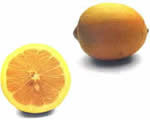 |
LEMON
Variety widely spread in California. Fruits of variable size, medium to large, spheric to oval, smooth and thin skin, short stem. High contents of juice, with some pips. External colour varies from silver green to yellow, according to season. Due to climate and varietal characteristics, many flowering occur, therefore production takes place practically all year round.
With a heavy crop between beginning of June to end of September. |
| |
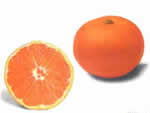 |
SATSUMA
Variety original from Japan, widely commercially extended in Spain and Morocco. Two varieties are mainly being produced in Uruguay: Owari and more recently Okitsu.
Its main feature is its earliness, being the Okitsu earlier than Owari.
Fruits of medium to large size, seedless and easy peeling, very juicy and extremely sweet.
The outside colour of fruits is variable, especially at the beginning of the crop where the greenish and yellowish coloration next to orange areas is persistent.
The sequency of the described varieties allows a wide distribution from mid-February until mid-May.
|
| |
 |
CLEMEND`OR
A mutation of unknown origin, most probably from Paysandú, in Uruguay. Maturing in June, July, the fruit is small to medium but production techniques such as prunning and fruitlet thinning can improve its size. It has a relatively short harvesting period of a few weeks. Clemend'or has all the exceptional flavour of the Mediterranean mandarin and it is seedless when grown in isolation but unfortunately retain the tendency to be strongly alternate - bearing.
|
| |
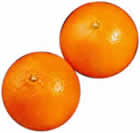 |
NOVA
(CLEMENVILLA, SUNTINA) Resulting from the cross between Fina Clementine and Orlando tangelo. The fruit is medium-large for a mandarin, good flavour and internal quality. It has an attractive orange to reddish-orange colour. Peeling is not so easy due to the firmness of the fruit, the thin rind and its tight adhesion, but once started it is easily completed with no oiling of the hands in the process. Moreover, virtually all the albedo is removed with the rind, leaving the segments as clean as the best Clementine. It has no puffing problems, its fruit is seedless. And has good preservation.
Harvest period in Uruguay is from mid of May to mid of June and it can be degreened without inconveniences although it is not essential. This is the difference with Clementine the Nules. |
| |
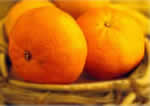 |
CLEMENTINA
Clementine, probably of Chinese origin, is the most spread variety in the Mediterranean area in the last decades. Several of its mutations, of Spanish origin, are being produced in Uruguay, as Nule, Marisol and Oroval. Its seedless fruits vary among different mutations but it has an orange colour is very intense. Its high contents of juice and the relation sugar/acidity makes it very desirable in the market.
The range of varieties widens the picking period from mid-April until the end of May. |
| |
 |
MINNEOLA
Originating in Florida, USA, it is known from the beginning of 1930s. It is the result of a cross between Duncan grapefruit with Dancy tangerine. The rind has not only exceptional colour, being reddish-orange, but also has a particularly fine, smooth texture and is an easypeeling. Minneolas have a unique and delicious flavour and have also a high percentage of juice. Large in size, the fruit has a round shape, with most fruits having a pronounced and distinctive neck, which leads to its immediate recognition by consumers. When grown in a solid block the fruit has few if any seeds.
Its harvesting period is from mid of June to the end of July.
|
| |
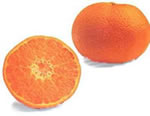 |
ELLENDALE
Variety selected in Australia, highly demanded in the international market. Fruits of medium to large size, normally somewhat flattened. The texture of the skin is smooth, and although thin, it is easy peeling without letting great quantity of essencial oil come out. Attractive colour, delicate and juicy pulp, and its taste is sweet although it maintains acid levels which provide an excellent sugar/acidity relation. Fruits have 3 to 5 seeds.
It is produced from mid-June until mid-Agoust.
|
| |
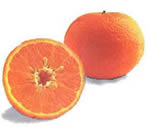 |
URUNIQUE
Tangor, natural hybrid.
Medium size fruits, slightly flattened in the stylar area, where sometimes a small navel may be observed.
Skin is consistent and it is not easy to peel.
Juice has attractive colour, very sweet flavour, intense and nice smell. Fruits have good preservation and average of 3 to 5 seeds.
It is produced from end of July until mid-September.
|
| |
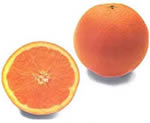 |
NAVEL
Probably originated in China, reaching Brazil from Portugal.
Fruits from the Navel group, are characterized for having no seeds, large size, easy peeling skin, highly intense orange colour, and a pleasant and sweet taste.
In Uruguay they are grown from the early varieties, Newhall and Navelinas going through the Washington which is the most important, until the late Navel.
Its supply extends from mid-May to mid-August.
|
| |
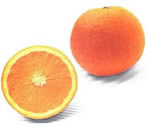 |
SALUSTIANA
Variety of Valencia origin, of recent commercial development in Uruguay.
Its fruits are medium, its skin is smooth and of medium thickness.
Its very delicate juice and smooth pulp makes of it a very desirable orange.
It has almost no pips and a very fine, delicious, sweet flavour.
It is offered from mid-June until beginning of August. |
| |
 |
VALENCIA
Probably of Portuguese origin.
Leader variety at world level. The most produced in Uruguay.
Fruits of medium size, well coloured skin, thin and consistent.
Its pulp has good colour, high contents of attractive, colorful and tasty juice, with few or no seeds.
All of these assets make of it an excellent variety for fresh consumption as well as for juice.
|
| |
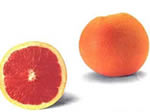 |
STAR RUBY
Variety obtained from irradiation of Hudson variety in Texas.
Its fruits develop external strong yellow colour with reddish areas.
Pulp is red to intense red, very high juice content of red colour.
It has almost no pips, skin is thin and smooth.
It is produced from mid-July to end of September. |
|
|
|
